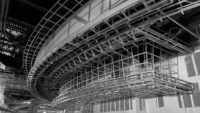The University of Toronto recently completed construction of a new addition to its School of Architecture. The top floor of the new Daniels Building facility features an expansive 16,000-square-foot open space designed to function as a studio and study hall for the students. The space features no interior walls or structural columns.
Towering above the massive space is a very contemporary drywall ceiling designed to replicate wings that reach eastward and westward away from the north-facing glass curtain wall. Hyperbolic paraboloid in shape, four angled drywall ceiling slabs gently twist from one side of the space to the other.
Creating the complex framing on which to attach the drywall was a key installation consideration. Project designers initially considered using metal studs. However, a number of factors presented potential problems, including the overall size and twist of each ceiling surface.
According to Robert Dell’Elce, vice president of Nelmar Drywall Co., of Vaughan, Ontario, the drywall contractor on the project, “Once we saw the initial drawings, we had our doubts it could be done with metal studs because of all the twists and turns.”
To find an alternative, the drawings were sent to Armstrong Ceiling Solutions to see if a drywall grid system was feasible. “We were familiar with drywall grid from a previous project and thought it would work here because of the flexibility it offered compared to metal studs,” he says.
Full-Scale Mock-Up Created
In order to ascertain that drywall grid would perform as desired, Armstrong created a full-scale mock-up at the local union training center using main beams, 4 feet cross tees, 16 inch on center, and 5/8-inch drywall.
“The mock-up showed that the framing was indeed possible using drywall grid and that gave us a level of confidence to proceed,” Dell’Elce says.
Following approval for its use, an initial challenge was the fact that this would be the first time many of the installation crews would be working with drywall grid, let alone on such an unusual shape. To remedy this, Armstrong held on-site training sessions to help ensure a hassle-free installation.
“The jobsite training assistance we received was a huge help,” Dell’Elce states, “otherwise it could have been a nightmare.”
Foreman Chris Morgan of Nelmar Drywall notes that the crews learned the technique quickly since “everything essentially snaps together just like the normal T-bar grid systems they were accustomed to.” Because of the ease and speed of installation, he estimates the drywall grid system probably installed in half the time as the original steel stud system, thereby significantly reducing labor on the project.
Morgan also notes that the drywall grid system maintained the smooth curvature of the ceiling very well, even with 5/8-inch drywall. “We were surprised how well the drywall mirrored the curve of the ceiling without even having to wet it,” he states.
Unique Shape Presented Challenges
The unique shape of the ceiling did present its own challenges. Because each ceiling surface has two pivot points on which it twists, establishing the correct set points to run the framing was among the most difficult challenges.
Another was the height of the ceiling, which rises to 31 feet at its highest point. Especially difficult was the installation of the ceiling over the staircase that leads up to the space. In addition, the floor featured a bubble deck construction which limited the size and weight of the lifts that could be used.
Looking back at the project and his first experience with a drywall grid system, Morgan states, “I would use it anytime I can now, especially in curved situations. I was amazed it worked so well.”
And as far as the future, Dell’Elce notes that the system is definitely increasing in use, stating, “Drywall grid is becoming much more common now as more and more architects become familiar with it.”
Note: The drywall ceiling installation at the University of Toronto took Gold in the Central Region, Education Category, of the 2018 CISCA Construction Excellence Awards.










